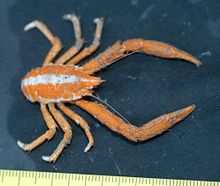Munidopsis serricornis
| Munidopsis serricornis | |
|---|---|

| |
| Scientific classification | |
| Domain: | Eukaryota |
| Kingdom: | Animalia |
| Phylum: | Arthropoda |
| Class: | Malacostraca |
| Order: | Decapoda |
| Suborder: | Pleocyemata |
| Infraorder: | Anomura |
| Family: | Munidopsidae |
| Genus: | Munidopsis |
| Species: | M. serricornis
|
| Binomial name | |
| Munidopsis serricornis | |
| Synonyms [2] | |
| |
Munidopsis serricornis is a species of squat lobster. It is widely distributed in the world's oceans, being found in the eastern Atlantic Ocean (from Iceland and Norway to the Cape Verde Islands), the western Atlantic Ocean (from the United States to the Gulf of Mexico), and the Indo-Pacific (from Australia and the Malay Archipelago to Madagascar).[3] It grows up to a carapace length of 20 millimetres (0.8 in).[4]
M. serricornis appears to be one of the most abundant megafauna species in the cold water coral reefs of southern Norway.[5] It has also been observed in association with the gorgonian Acanthogorgia.[6]
M. serricornis was the first species of the current genus Munidopsis to be described, when Sven Lovén described it (as Galathea serricornis) in 1852. It was described independently in 1857 under the name Galathea tridentata by Laurits Esmark.[7]
References[edit]
- ^ "Munidopsis serricornis (Loven, 1852)". Integrated Taxonomic Information System. Retrieved October 22, 2010.
- ^ Keiji Baba; Enrique Macpherson; Gary C. B. Poore; Shane T. Ahyong; Adriana Bermudez; Patricia Cabezas; Chia-Wei Lin; Martha Nizinski; Celso Rodrigues; Kareen E. Schnabel (2008). "Catalogue of squat lobsters of the world (Crustacea: Decapoda: Anomura — families Chirostylidae, Galatheidae and Kiwaidae)" (PDF). Zootaxa. 1905: 1–220.
- ^ Masayuki Osawa, Chia-Wei Lin & Tin-Yam Chan (2008). "Species of Galacantha and Munidopsis (Crustacea: Decapoda: Anomura: Galatheidae) from the deep-waters off Taiwan, with the description of two new species". Scientia Marina. 72 (1): 37–57. doi:10.3989/scimar.2008.72n137.
- ^ Matz Berggren (2006). "Munidopsis serricornis – Trollhumrar" (PDF) (in Swedish). Sveriges Lantbruksuniversitet.[permanent dead link]
- ^ Marc Lavaleye; Gerard Duineveld; Tomas Lundälv; Martin White; Damien Guihen; Kostas Kiriakoulakis & George A. Wolff (2009). "Cold-water corals on the Tisler Reef: preliminary observations on the dynamic reef environment" (PDF). Oceanography. 22 (1): 54–62. Archived from the original (PDF) on 2016-03-04. Retrieved 2009-12-08.
- ^ Enrique Macpherson & Michel Segonzac (2005). "Species of the genus Munidopsis (Crustacea, Decapoda, Galatheidae) from the deep Atlantic Ocean, including cold-seep and hydrothermal vent areas" (PDF). Zootaxa. 1095: 1–60.
- ^ Enrique Macpherson (2007). "Species of the genus Munidopsis Whiteaves, 1784 from the Indian and Pacific Oceans and reestablishment of the genus Galacantha A. Milne-Edwards, 1880 (Crustacea, Decapoda, Galatheidae)" (PDF). Zootaxa. 1417: 1–135.
